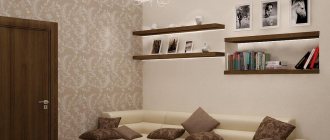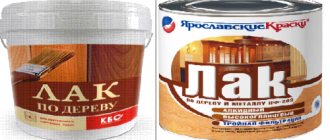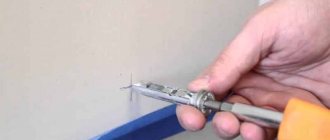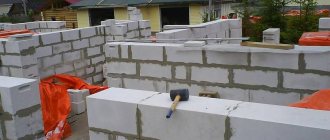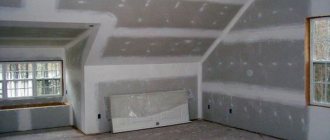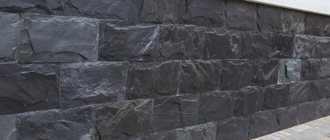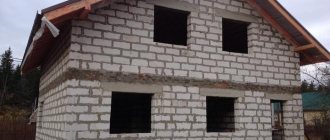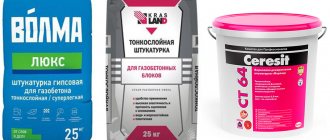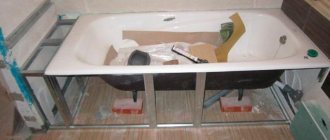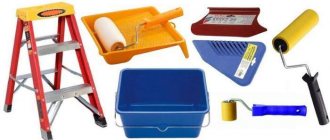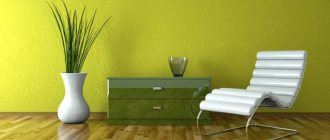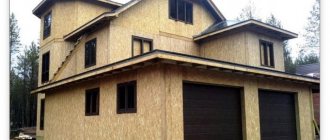With all the possibilities of modern industry, which produces various finishing materials, it is better to choose between gypsum and cement-sand mortar. With their help, the inside of a house made of expanded clay concrete is plastered and brought to the desired condition. Let's consider both options.
Interior decoration of a house made of expanded clay concrete blocks using gypsum plaster is noticeably easier in terms of work. Moreover, you get a warmer house than with a cement-sand mortar. Before applying the material to the walls, the working surface must be treated with concrete contact - this is done to improve adhesion and high-quality adhesion of the material to expanded clay.
There are often plasters on sale that can be applied without prior preparation of the walls using concrete contact. For better results, it is recommended to use reinforcing material: polymer or steel mesh. In general, the polymer is even beneficial because it has higher performance characteristics.
Regarding cement-sand plaster, it is worth noting that its composition is not much different from ordinary wall material. This gives a significant gain in the adhesive properties of the working surface. However, in practical terms, working with such plaster is somewhat more difficult than with gypsum.
Particular attention should be paid when using reinforcing galvanized fine mesh, as additional tools and special fasteners will be required.
To fix the mesh, you need to make small diameter holes in the wall with a puncher. Dowels are inserted into them and a mesh is placed, and then secured with self-tapping screws. It turns out that the interior finishing of expanded clay concrete blocks using cement-sand plaster is a more labor-intensive task.
What is the best way to clad a house with expanded clay concrete blocks?
- Activities for finishing the buildingVariants for wall claddingPlastering of expanded clay blocksExternal covering of a house made of expanded clay concrete blocks
Buildings constructed from expanded clay concrete are finished in most cases, since an unprotected building will not be able to please its owners with durability.
As a result of unfavorable natural phenomena, unnecessary moisture appears in the space between the outer and inner base. And it, in turn, will destroy the building material. The external indicators of such blocks will not please with beauty, grace and nobility.
How to clad a house made of expanded clay concrete blocks? This question is asked by a large number of people who are constructing such a building. The information below will help you resolve the issue.
Floor plan for an expanded clay concrete house.
Building finishing activities
You can clad a house made of expanded clay concrete blocks with the following materials: ceramic facing or clinker bricks, crushed stone, plastic molds, different types of plaster. Taking into account the external nature of the finish, something should be said about the insulating layer.
In most cases, it is installed on the outside of the house. Thus, he is not able to reduce the area of the premises from the inside. Allows you to protect walls and heat-insulating material from the appearance of condensation, which has a detrimental effect on the base of expanded clay concrete blocks.
Characteristics of expanded clay concrete blocks.
The following samples are used as insulating components in the design of the external shells of a house:
- Polystyrene foam, which is one of the simplest and most popular bases. Mineral wool, it contains basalt fiber. A material of this nature retains its shape for a long time and is not subject to destruction. Fiberglass, which is characterized by its low cost.
A house made of expanded clay concrete blocks, like buildings with other design options, is finished from the inside in the same way.
To do this, use gypsum and cement-sand plaster. The possibility of decorating with clapboard, plasterboard, and plastic panels is also not excluded. Suitable for this option would be metal profiles and guide bars.
Return to contents
Sheathing with plasterboard sheets
There is another way to finish an expanded clay concrete wall from the inside of a building - covering it with plasterboard sheets.
Expanded clay concrete blocks hold anchors, screws, etc. very well, so metal profiles are attached directly to the wall. In the space between the wall and the plasterboard, you can lay an additional layer of insulation - an additional advantage of using plasterboard sheets.
Installation of plasterboard sheets is the same as for other types of walls, very simple and quick. Afterwards all that remains is to putty the joints of the plasterboard sheets and cover the entire surface with a thin layer of finishing putty.
Wall covering with plasterboard sheets
Installation of plasterboard sheets is the easiest type of room finishing, but do not forget that this method conceals space.
The three methods described above are the most suitable types of finishing expanded clay concrete blocks. Which one will be better for you, decide for yourself. You can also learn how to properly prepare plaster solutions and apply them to the surface on our website. Have a nice renovation!
Wall cladding options
Reduced heat transfer resistance of various enclosing structures.
Natural stone or ceramic tiles are installed directly on a wall made of expanded clay concrete blocks; there is no need for preparatory work. For better fastening of these materials, use tile adhesive or a mixture of cement and sand.
As noted earlier, the buildings of the sample in question are not left bare, unprotected from the external influences of nature. Of course, if we are not talking about high-quality facing bricks. Despite the fact that buildings made of expanded clay blocks are lightweight, it is very important to correctly calculate the foundation.
Therefore, the low weight of such materials does not provide grounds for constructing a lightweight version of the foundation. The disadvantage of such ceilings is their low thermal conductivity. Before facing external walls, care must be taken to carry out insulation measures.
Thus, mineral wool does not burn; a layer of plaster can be applied to it using a special mesh.
The same cannot be said about mineral wool. It is intended for decorating a building with siding and other materials in the form of panels. Mineral wool laid under the siding must be protected from the wind.
For such purposes, membranes are used that have the properties of protecting from wind and moisture. In this case, the insulation will be dry and provide reliable protection from rain and wind. There are also insulation materials based on mineral wool with a special durable layer on which plaster can be applied.
It is worth noting that the external decoration of the walls of a house with panels made of plastic or siding will not be such a complex undertaking, unlike finishing the surface with plaster. If plastering the base of a house can only be done by an experienced craftsman, then here you can do all the work yourself. Sometimes the method of painting walls without first plastering the surface is used, but it is used very rarely.
Diagram of the design of a heating block with expanded clay concrete.
One of the frequently used options for finishing the external shells of a house is ceramic, clinker and brick cladding.
The least expensive option would be to treat the surface with a layer of cement-sand plaster. The latter finishing option, together with facade paints, helps to create original surfaces and an unusual appearance. Plaster has the best possible contact with expanded clay concrete; it is actively used for bases that constantly change under the influence of external temperatures and are periodically damaged. The façade, lined with natural stone, looks very beautiful and original.
It is not afraid of frost, and at the same time it looks monolithic, chic and unusual. This material can easily be replaced with artificial stone. It is no worse than the natural option, and it costs much less.
As a finishing option, thermal panels made of polyurethane and clinker tiles will complement the external shells of the house well. This finishing method can be called the least expensive.
Panels of this type are lightweight and are often used with a strip base. They are strong, environmentally friendly, and create a stable microclimate in the room regardless of the season. Installation work is extremely simple; even a non-professional can do it.
Ventilated facades skillfully hide possible flaws in wall coverings. In the space between the wall and the facing layer there is a constant movement of air, as a result of which the base is not subject to destructive influence.
Siding can be considered an inexpensive option for decorating external walls. However, such panels are quite fragile and can break, which does not reflect well on a wall made of expanded clay concrete. Houses made from this material can last a century, but it is important to choose the right finishing option so that the foundation is reliably completed.
Return to contents
Technology of applying plaster composition to expanded clay concrete blocks
External and internal application of plaster composition to expanded clay concrete blocks can only be carried out if you have the appropriate experience. To begin with, the surface is prepared, which involves not only removing defects, but also applying a primer.
The most important stage is plastering. If necessary, the solution must be prepared and pigmented. If special equipment is available, mechanized plastering can be performed. With the help of such installations, the solution is mixed without the involvement of a person and quite quickly.
Preparing the wall surface
Expanded clay blocks must be prepared before applying facade plaster to the walls of the house. To do this, all dirt is removed from the blocks, as well as oil stains, as well as everything that can reduce grip. A positive quality is that the layer of plaster mortar will practically not be absorbed into expanded clay concrete blocks, which have low water absorption.
As a preparatory layer, you can combine water with cement to create a solution that is applied before the main layer of plaster. This is true if the finishing is carried out on the basis of cement and sand. Expanded clay concrete masonry turns out to be quite smooth, so a layer of the mixture is poured in such a way as to form no more than 1.5 cm. If the work was not carried out by professionals, then the laying may have some defects, then the consumption of plaster will increase.
Preparation of plaster mortar and its application
If the solution was purchased in dry form, it will need to be combined with water and color added if necessary. Mixing in this case is carried out using a drill, which is turned on at low speed. When the solution is purchased ready-made, it can be applied immediately. Laying should be done with a trowel, and leveling should be done using a rule. To make this possible, beacons are pre-installed. 6 hours after applying the first layer, rub it well, and then begin applying the finishing layer.
Nuances of the work
If the house is not new, then its external walls also need to be freed from old finishing, even if it seems suitable for plastering. Sealing of cracks and seams is carried out flush with the surface. You can also use a ready-made solution for this. Sometimes you buy putty intended for seams. After preparing the laitance for the first layer of primer, the composition must be applied to the surface with a brush. You need to move it horizontally, which will increase adhesion between the layers.
Then you can start filling the mesh. If it is not there, you can replace the layer with staples. An alternative is metal anchors with washers. When placing beacons, you need to make sure that their position is level. In this case, you need to use a level or plumb line. A distance of 1.5 m is left between these elements, which will allow you to conveniently work with the 2 m rule.
The beacons are fastened using cement mortar.
When preparing the mixture yourself, you need to carry out this work using a wide tray. If you don’t have a mixer, you can use a spatula to bring the mixture to the consistency of liquid puree.
The solution can be poured onto the base with a ladle, and smoothing is carried out from the bottom up. The rule is to move not only down, but also left and right. The final layer is applied using a trowel. You need to try to fill all the depressions with the mixture. As soon as this layer has set, you need to grout it with a float, which the master moves at a run or in a circle. Once the plaster has dried, it needs to be primed or painted. Sometimes the surface is covered with any finishing, it can be decorative putty.
Mechanized block plastering
If you decide to decorate your home outside or inside using special equipment, you will receive many advantages. Firstly, the composition can be mixed in a short time, without using buckets and mixers. Secondly, it’s much easier to do this, and you won’t waste any effort. Thirdly, application can be done in an even layer; the machine will do almost everything for you.
The solution adheres well to the surface, and the layer is more durable, because it is supplied under pressure. Less building materials are consumed and labor costs are reduced. If you decide to use the device, you should select a special dry mixture. By finishing the interior walls in this way, you will be able to use any finishing materials for subsequent interior finishing.
External covering of a house made of expanded clay concrete blocks
Insulation of expanded clay concrete walls with fiberglass.
A house made of expanded clay concrete blocks, the plan of which provides for the outer covering of the walls, is fixed during their construction with a special mesh resembling metal wire with a diameter of 3-4 mm. It is placed in a certain interval, after 2 rows of blocks. The mesh has a slight thickness, so the heat conductivity coefficient will remain at the same level.
The external wall, finished with facing bricks, is connected to the internal partition along the perimeter of the building. Many experienced craftsmen build 2 walls at once, one of which is the base, and the other is the finishing option. The laid mesh will not corrode.
A house made of expanded clay concrete blocks may have elastic plastic fasteners as options for securing the covering cladding. Here a ventilation opening is constructed, located in the space between the outer base and the layer to retain heat. A rod with a dowel sleeve and an anchor acts as a latch.
On the main wall, recesses are made at a distance of 50-60 cm vertically and 40-50 cm horizontally. Dowels are driven into them. The base, which serves the purpose of the heat insulator, is mounted on dowels and snapped into place with plastic clips.
A structure made of expanded clay concrete blocks, not insulated with material, requires connection to the supporting structure with clamps, that is, strips of a steel base taking the shape of the letter “L”. The clamps are fixed at a distance of 50-60 mm.
The high performance of cladding buildings made of expanded clay concrete blocks is determined by the nature of the building materials used and the experience of the craftsmen.
Based on materials from the site: https://ostroymaterialah.ru
Question: Good afternoon, dear gentlemen! Please tell us how best to decorate the outside of a house made of expanded clay concrete blocks (KBB), what facade would be appropriate here, what materials can be used? Arthur Shakarin, Novosibirsk
Answered by Semyon Fiskunov, Stroy-Alliance CJSC, Tolyatti.
Answer: Hello, Arthur! I'll try to answer your question in detail. Moreover, KBB is a fairly popular material; many owners build their houses from expanded clay concrete blocks.
First of all, I would like to ask you a counter question - how thick are the expanded clay concrete walls you built? The question is not an idle one.
It depends on your answer whether you will have to insulate your walls from KBB, or whether you can immediately begin finishing the exterior and applying a decorative layer.
Features of expanded clay concrete blocks with cladding
Expanded clay concrete blocks are used for the construction of walls of residential buildings and in commercial construction.
Their light weight and good strength, density, and geometry make it possible to speed up the laying process several times.
One of the varieties of such material is expanded clay concrete products with cladding. This stone has a decorative coating on one side, which allows it to be used not only for the construction of walls, but also for decoration.
What are these expanded clay stones?
Expanded clay concrete block with cladding is a modern building material that allows you to construct buildings and other structures with a fine front surface . The use of such raw materials makes it possible to reduce finishing costs several times, but on the other hand, laying with such stone must be perfect, because later you will not be able to hide the flaws.
Expanded clay concrete facing type comes in different types, it can also be painted in different shades, which allows home owners to make a choice. The decorative function of this raw material is maximized, which is why it is well suited for the construction of external walls.
What are they?
Cladding-type expanded clay concrete products are:
- Colored . They look like ordinary expanded clay concrete, only painted in different shades. As you know, the clay from which expanded clay is produced does not have a wide color palette, so more often than not ordinary blocks turn out either gray due to cement, or slightly reddish due to clay. Therefore, manufacturers can paint the stone a certain color. The blocks can be dark red, green, blue and yellow. They do not require additional finishing, as they are good on their own.
- With decorative coating or cladding. Has a slightly different composition. This is a block of expanded clay and cement, but there is decor on the front part of it. It is represented by a unique structure that can imitate wood, natural stone, plaster, and lining. The use of such products allows you to diversify the facade of the house without additional finishing.
- With insulation . These are insulated stones made of expanded clay concrete. The block is taken as the basis, then there is an insulating layer, and then the cladding. High-density polystyrene foam is used as an insulating layer: raw materials of this type are inexpensive. Mineral wool can be found in foreign-made stone as insulation. Sometimes polyurethane foam is used. The density of the foam in the insulating layer is from 30 to 70 kg/m³. It is foam plastic with the required thermal conductivity coefficient of 0.036 W/μ, which guarantees a reliably insulated house.
Requirements according to GOST
Features and requirements for expanded clay concrete products with cladding are set out in GOST 6133-99. It says this:
- facing blocks can be solid, slotted or hollow;
- standard block size is 390x190x188 mm, but deviations from the norm of 3-4 mm are allowed on each side;
- facing stone is intended for laying walls without subsequent finishing;
- the strength grade must be at least M50;
- The front block can have either one or two facing faces.
When choosing a facing stone for wall construction, you should be guided by the GOST document.
What types of walls are they used for?
Clad blocks made of expanded clay and concrete are used for the construction of :
With the help of such building material, you can not only build walls, but also simply veneer them. Expanded clay concrete block with decor is perfect for cladding wood-frame houses. However, this building material is not used for the construction of internal walls of the room, as well as for plinths.
Main characteristics of the material
Such stones have several main characteristics:
- can be solid, slotted or hollow, depending on this their characteristics change;
- strength grade within M50-M150;
- weight – from 12 kg;
- volumetric weight – 700-1500 kg/cub.m;
- frost resistance – 50 cycles of defrosting and freezing;
- thermal conductivity - 0.15-0.45 W/mG;
- wall cooling time – from 75 to 90 hours;
- water absorption – 50%.
Shrinkage is 0%, so this material has become very popular in the construction and cladding of walls.
Separately, it is worth mentioning the size of the block. It comes in sizes 390x190x190 mm, 390x188x188 mm, 390x190x188 mm. The dimensions are similar to the standard sizes of blocks that are used in construction, so this material can be used for the construction of load-bearing walls of a house.
It is recommended to use special solutions for laying such blocks . Since there will be no insulation in the future, it is better to use compounds with thermal insulation characteristics. They can also use reinforcing additives.
It is better if the stone is produced with a tongue-and-groove fastening, then the connection of two adjacent expanded clay blocks is simplified.
Since the facade block is the only material and nothing is used after it, it is important to maintain the exact evenness of the masonry . To do this, be sure to pull the string, plumb line, and after laying each stone, check the evenness with a building level. A laser level will provide the greatest accuracy.
At the end of the laying, it is necessary to check all the stones for cleanliness. It is possible that during the work some of the solution got onto the front side, which will spoil the appearance. To eliminate errors, it is better to immediately remove excess glue.
Pros and cons of use
There are several main advantages of using such a stone:
- installation speed increases;
- no need for finishing;
- work is done easily;
- good thermal insulation performance can be achieved;
- construction costs are reduced;
- the blocks are fire-resistant, environmentally friendly and durable.
One of the disadvantages is the thoroughness of the work, since you need to lay the stone immediately “for finishing”. Also one of the disadvantages is the need for constant maintenance of the cladding.
Prices for stones with decoration
As an example of cost, you can consider several options for facing blocks made of expanded clay:
- front color full-bodied 390x95x188 mm – 72 rub. per piece, 12,000 per cubic meter;
- colored gray 2-hollow double-sided 390x120x188 mm – 42 rub. per piece, 5250 rub. per cube;
- chipped gray solid 380x95x188 mm – 52 rub. per piece, 8600 rubles per 1 cubic meter;
- decorative red, brown 2-hollow 390x190x188 mm – 77 rub. per piece, 5900 rub. per cubic meter.
As you can see, average prices will differ depending on the type of stone - slotted, hollow or solid, its color and texture.
Conclusion
Expanded clay concrete products with cladding consist of a main block and a façade textured or colored part, which can be presented on both sides. There are products with insulation, which is foam or mineral wool. When laying such raw materials, care must be taken to ensure the accuracy and evenness of the rows. The main advantage: savings on finishing the facade of the building.
Ventilated façade on KBB walls
If you have chosen a ventilated façade and insulated your house with basalt wool, you can install it in a wooden sheathing or in the space between steel hangers. I do not recommend you insulate a house made of KBB with polystyrene foam under a ventilated façade.
Why? Because there are several reasons why polystyrene foam is completely unsuitable as insulation for a ventilated façade:
- Polystyrene foam is a flammable material, it cannot be used in systems with a ventilated facade. Rodents feel great in such a cake if you still make foam plastic into the ventilated facade. The movement of air in the ventilation gap and the moisture removed will eventually make a set of individual foam balls from the foam sheets. Your insulation will flow down the ventilation gap.
Basalt wool, which you can use, does not have these shortcomings in the ventilation façade. You can also use polyurethane foam, resole foam or ecowool.
After installing the sheathing or hangers and subsequent insulation, you can install the outer decorative layer on the ventilated facade.
What is suitable in this case for a house made of KBB:
- Porcelain tilesClinker panelsVinyl sidingMetal sidingFiber cement panelsPlankenBlock house
These materials can be used to form a decorative layer in the ventilation façade for your home. How to install them - see on this website, everything is described in detail.
Wet facade on the walls of a house made of KBB
If you want to make a wet facade on your house, then after preparing the walls (leveling, filling cracks, removing excess mortar), you can start insulating the walls of the house.
You can use basalt wool with a density of 45 or more and facade foam with a density of 25 or more. The wool is mounted on façade dowels, the foam is mounted with glue and additionally on façade dowels.
At the time of installation of the insulation, a façade fiberglass mesh is attached on top of it, which will reinforce the plaster layer. The mesh is attached with the same façade dowels with “fungi” that hold the insulation to the wall.
After installing the fiberglass mesh, a base primer layer or two-component plaster is applied. Next, the plaster is primed with penetrating primer. Modern facade systems make it possible to maintain the plaster layer in a semi-plastic state, which guarantees its long-term operation.
After priming, you can prepare for applying a decorative layer or painting.
You can use the following decorative coating options:
- Painting with facade paintDecorative plaster bark beetlePlaster coatDecorative smalt plaster
After applying the decorative layer, you can use fixing compounds and facade varnishes. They will protect the decorative layer from contamination and possible destruction.
PS.
Under no circumstances should you insulate a house made of expanded clay concrete from the inside. Expanded clay concrete is actually a vapor-tight material. Moisture from the premises will be locked between the insulation blocks INSIDE the room. In this case, you will have all the adverse consequences - dampness in the room, mold under the insulation, and so on.
Expanded clay concrete blocks are in demand in modern private construction.
Using it you can implement almost any project. But when the object is ready, the question often arises of how finishing work should be done. Houses made of ceramic blocks allow you to implement many tasks.
Insulation
When working on the facade, the following must be taken into account:
- practice shows that one of the best options for external finishing is the laying of a thermally insulating expanded clay concrete block, which compensates for heat loss up to 75%; additional insulation is mineral wool or foam plastic/expanded polystyrene; the foam plastic is fixed on the cleaned base using an adhesive composition, and is additionally secured with dowels. All seams are treated with polyurethane foam; mineral wool requires stripping, gluing and reinforcement of wall structures to increase the strength of the structure; the use of penoizol will achieve sound and waterproofing and reduce thermal conductivity.
Finishing
The basic principles of work are as follows:
- expanded clay block walls lined with brick do not require additional processing, as they have a presentable appearance; you can use clinker tiles, stone (artificial or natural), thermal panels or siding; the most common option is to cover the walls with cement-sand based plaster.
Natural stone looks noble and aesthetically pleasing, however, when choosing a material, you need to pay attention to its frost resistance. Brick is not inferior to stone in its functionality and aesthetics, but is much cheaper.
Facade work using thermal panels is an economical cladding method. The panels consist of polyurethane foam and clinker tiles. This is a lightweight material that has shown effective use on strip foundations; in addition, it is very easy to install.
Ventilated facade systems effectively cover all defects in wall structures and prevent their destruction. Siding can be fragile, and its damage during operation negatively affects expanded clay concrete masonry, which is confirmed by photos and reviews related to houses made of expanded clay concrete blocks.
Work with tile or panel materials requires the installation of sheathing. The finished structure can withstand dynamic and static loads
Decorative Finishing with Expanded Clay Concrete Blocks with Cladding
Wall block with a decorative front surface Expanded
clay concrete blocks are valued for their excellent characteristics: strength, relative lightness, low thermal conductivity, frost resistance, etc. They are widely used for the construction of residential buildings and outbuildings.
Until recently, their only drawback was their unsightly appearance, forcing them to think about decorative design of the facades. However, if you use expanded clay concrete blocks with cladding, you can forget about it.
This article will help you learn more about this material.
Decorative expanded clay blocks
First, it’s worth saying a few words about expanded clay concrete and its properties. In addition to sand and cement, it contains expanded clay. This material is produced by firing clay in a rotary kiln. As a result of rotation and rapid firing, it foams, turning into porous granules ranging in size from 5 to 40 mm.
In the photo - expanded clay granules
Expanded clay itself is an excellent bulk insulation material with many positive properties. The presence of these granules in wall blocks changes their characteristics for the better.
Unlike conventional concrete or cinder blocks, expanded clay concrete products have:
- Less weight;
- The best heat and sound insulation performance;
- High resistance to moisture;
- The ability to “breathe” by regulating the humidity in the room.
Ordinary blocks of expanded clay concrete
Due to its lower weight, it is easier to build walls from this material. But after construction is completed, the question arises: how to veneer expanded clay concrete? After all, you want to give even an outbuilding a decent appearance, not to mention a residential building.
This problem will not arise if you use a facing expanded clay concrete block instead of the usual one. Possessing all the listed advantages, it also performs decorative functions at the same time as load-bearing.
Decorative products are divided into two groups: colored and lined blocks.
Colored expanded clay blocks
They differ from ordinary ones only in color, since inorganic dyes are mixed into the raw materials during the manufacturing process. The block turns out to be painted in the mass, so even small chips do not spoil its appearance.
Otherwise, the colored expanded clay concrete facing block is completely identical to its gray counterpart, both in size and technical parameters.
- Depending on the manufacturer, it may have different geometric dimensions, but the most common are 390x190x190 mm;
- Colored profiled blocks are also produced with a tongue-and-groove system at the ends, during the laying of which the vertical joints are not filled with mortar;
Profiled color block
- The surface can also be different: untreated, polished, chipped or with a corrugated texture.
Expanded clay concrete besser blocks with crushed front surface
For reference. The price of colored products is higher. If a gray block costs on average 32 rubles, then a colored block costs from 40 rubles. Decorative surface treatments also increase the cost. For example, a besser of similar sizes costs 67 rubles and more.
Expanded clay concrete blocks painted in the mass are used primarily for the construction of non-residential buildings and fences.
Beautiful fence made of colored wall blocks
Blocks with textured coating
One of the disadvantages of expanded clay concrete is its ability to absorb moisture. And the lining of expanded clay concrete blocks is carried out not only for decorative purposes, but also to protect it from precipitation.
Therefore, colored products without additional external finishing are still rarely used for the construction of buildings in which it is necessary to maintain a microclimate comfortable for human life.
To save not only money but also time on finishing facades, it is better to purchase blocks already lined with artificial stone tiles. Structurally, they have the same composition, and can also be of different sizes, hollow and solid. But one or two sides imitate the surface of materials such as brick, plaster or natural stone.
They are produced using vibration casting technology, which allows the front surface of the block to be given the desired color and texture. And to simplify masonry work, blocks are produced in different formats: regular, corner, half, four-sided (pillar), etc.
The advantages of using this material are obvious:
- Lined expanded clay concrete has a higher level of frost resistance , since moisture cannot penetrate under the dense finishing layer and freeze in the pores;
- Construction time is significantly reduced due to the absence of the need for facade finishing;
- There is a saving of money spent on construction;
- If you have the skill of masonry work, you can build a house with your own hands , without involving finishers;
- A wide range of decor for the front surface of the blocks allows you to choose the option that best suits your taste and matches the surrounding landscape;
- The presence of a decorative layer does not reduce the load-bearing capacity of the material ; buildings up to 4 floors high can be erected from it.
Note. Due to the denser facing slab, the weight of the blocks increases compared to classic products. Take this into account when designing the foundation.
Heat blocks
Concrete, even with expanded clay filler, is not the “warmest” material. Therefore, the products described above, popular in areas with mild climates, are used in cold regions for housing construction only in two-layer structures. Buildings with walls in one block do not have high thermal efficiency and require additional insulation.
But this problem was also solved: not so long ago, three-layer expanded clay concrete blocks with cladding and insulation made of dense foam plastic or penoplex appeared on the market. Essentially, it is a sandwich consisting of load-bearing, insulating and façade layers.
Three-layer heat block structure
This is a unique material that allows you to build warm, reliable and beautiful houses in the shortest possible time. For example, a one-story building with an area of 150-160 square meters, insulated and tiled along the entire perimeter, can be erected by a team of masons in just two weeks.
However, it is worth remembering that due to the thickness of the insulation layer, the thickness of the load-bearing layer decreases, which imposes restrictions on the use of such blocks in the construction of tall structures.
For example, consider the products of the Cheboksary Alstroy plant. It produces heat blocks in two sizes:
- 400x400x190 mm with a load-bearing layer thickness of 150 mm, insulation layer 180 mm and façade layer 70 mm. The instructions allow the use of such products for the construction of buildings up to 4 floors high.
Wall heat blocks with original decor
- 300x400x190 mm with a load-bearing and insulating layer of 120 mm and a façade layer of 60 mm. They are used only in one-story construction or when constructing the top floor of a building.
The difference in layer thickness is clearly visible here.
Manufacturers also took care of the production of non-standard products, with the help of which the internal and external corners of buildings are easily drawn out, window and door openings are designed.
Various modifications of heat blocks
The great advantage of this material is that, despite the small thickness of the walls, it retains heat well: its thermal efficiency is 4 times higher than that of a conventional expanded clay block. And an additional bonus will be an increase in the usable area of the house by 10% compared to a block building, insulated and finished in the traditional way.
The same three layers, but with much more labor and time
Wet facade on expanded clay concrete walls
The work is carried out after the walls have been leveled, all cracks have been filled with putty, and excess mortar has been removed.
Sequencing:
- first, insulation is laid, for which you can use façade foam plastic or basalt wool; the foam plastic is fixed with glue and façade dowels, cotton wool material - with façade dowels; façade fiberglass mesh is used as reinforcement, which is attached using the same dowels with fungi; two-component plaster is applied to the surface or a primer layer; the plaster is primed with penetrating primer; high-quality facade systems help maintain the plaster layer in a semi-plastic state, which guarantees long-term operation; after priming, you can begin preparing the surface for applying a decorative or paint coating.
Among all the options, you can use the following:
- decorative smalt plaster; “fur coat” plaster; decorative “bark beetle” plaster; painting with facade paint.
Facade varnishes or other fixing compounds are often applied to the decorative layer to protect the coating from possible destruction and contamination. Reviews for such houses made of expanded clay concrete blocks have been very positive.
Prices for stones with decoration
As an example of cost, you can consider several options for facing blocks made of expanded clay:
front color full-bodied 390x95x188 mm – 72 rub. per piece, 12,000 per cubic meter;- colored gray 2-hollow double-sided 390x120x188 mm – 42 rub. per piece, 5250 rub. per cube;
- chipped gray solid 380x95x188 mm – 52 rub. per piece, 8600 rubles per 1 cubic meter;
- decorative red, brown 2-hollow 390x190x188 mm – 77 rub. per piece, 5900 rub. per cubic meter.
As you can see, average prices will differ depending on the type of stone - slotted, hollow or solid, its color and texture.
Arrangement of plaster “under a fur coat”
Work can be carried out without insulation or on this layer. The method, known as finishing the facade “under a fur coat,” is carried out using spraying or spraying a solution. This method is less labor-intensive than working with other materials.
Special devices have been created for working with the solution. The device can be very simple, manually operated, or more technologically advanced, such as an air gun. At the construction site, the required mobility of the mixture is selected and finishing begins.
When choosing materials, you should initially evaluate the amount of work. The final finishing cost may be too high
House made of expanded clay concrete blocks - interior finishing options
The objectives of this stage of work are to protect the walls from adverse effects, model design solutions, environmental friendliness and comfort of housing. By choosing to build a house from expanded clay concrete blocks on a turnkey basis, you can get a building that is completely ready for use, with completed interior decoration.
Work can be carried out using the following materials:
- ceramic tiles; plaster; lining based on plastic or wood; wallpaper.
Main characteristics of the material
Such stones have several main characteristics:
can be solid, slotted or hollow, depending on this their characteristics change;- strength grade within M50-M150;
- weight – from 12 kg;
- volumetric weight – 700-1500 kg/cub.m;
- frost resistance – 50 cycles of defrosting and freezing;
- thermal conductivity - 0.15-0.45 W/mG;
- wall cooling time – from 75 to 90 hours;
- water absorption – 50%.
Shrinkage is 0%, so this material has become very popular in the construction and cladding of walls.
Separately, it is worth mentioning the size of the block. It comes in sizes 390x190x190 mm, 390x188x188 mm, 390x190x188 mm. The dimensions are similar to the standard sizes of blocks that are used in construction, so this material can be used for the construction of load-bearing walls of a house.
Application of plaster mixtures
This is one of the most economical and affordable options, which makes it the most popular.
Working compositions can be as follows:
- decorative plaster – gives the surface a finished, aesthetically attractive look. Various textures and shades are available for sale, including those with glitter, stone chips, fabric fibers; starting - used to eliminate defects in the base layer; finishing - masks unevenness of the previous coating.
The working mixture is applied to an expanded clay concrete wall using a special reinforcing mesh, with the exception of decorative coatings. To decide on the choice of plaster, you should focus on the humidity of the room. The most suitable are gypsum mixtures that provide an aesthetic appearance and are used for painting.
The use of gypsum plaster allows you to obtain:
- ease of work; a warmer house compared to solutions based on sand and cement; high adhesion, which is ensured by treating the wall with the “Concrete-Contact” solution.
For better results when plastering, it is recommended to use steel or polymer mesh, which is more advantageous based on performance characteristics.
Cement-sand mixtures have the following properties:
- the composition is not much different from standard wall material, which allows for an advantage in terms of adhesion to the working surface; in practical applications, manipulations with such compositions are more labor-intensive.
Cladding a house with expanded clay blocks with your own hands | Finishing experts
Gusevsky Andrey Anatolyevich Individual construction and expanded clay blocks in finishing
Expanded clay concrete blocks, used for individual construction, construction of houses and other buildings, they can be classified as a series of new materials. They allow you to build a house with your own hands in one summer season.
An example was the neighbors nearby, who together with his wife built a box house during the period May-September during non-working hours and weekends. The motivation was rented housing, lack of money to buy an apartment and two children.
Photos and videos of a selection of ready-made buildings with a small plot of land will help you choose a house to your taste; this is now the dream of many city residents.
What speaks in favor of expanded clay concrete
Building blocks produced by vibrocompression of mixtures of cement, expanded clay gravel and water have a number of advantages:
- An ordinary, smooth block made of expanded clay concrete SKTs-14R, size 390x188/196x140, weighs 10.9 kg, and in general the weight is determined by the parameters of the products and their purpose.
- Houses can withstand a long service life of 50 to 100 years with positive reviews if the technological processes are followed. Withstands 50 freezing and defrosting cycles.
- The thermal insulation properties of the material make it a preferred product in cold and hot climates.
- Environmental safety, accessibility, cost-effectiveness.
- The foundations of multi-storey buildings experience less load when using expanded clay concrete blocks in construction.
- The flat surface and optimal format of the blocks allows installation quickly, easily, and saves on mortar.
- Houses made from facing expanded clay blocks are built in a variety of architectural designs. You can make door and window openings in block walls and partitions without special equipment.
- The size and shape of expanded clay blocks are convenient for transportation by road and rail. Laying is done in batches, on pallets, without the installation of additional wooden devices. Unloading them onto the construction site, storing them and storing them is also no problem.
- It goes well with concrete, reinforced concrete, foam blocks and other materials.
- The use of blocks for building a house reduces heat loss in the building by 75%
Attention: The level of thermal protection and sound insulation of a porous expanded clay block is not lower than that of ordinary concrete.
- A set of positive properties and characteristics make this product universal. High speed of construction is ensured, the amount of mortar is reduced, the speed of construction of buildings is reduced by up to 4-5 times, construction costs are reduced, because the cost of expanded clay blocks is lower than bricks and the reliability and quality parameters of buildings are not lost.
- Disadvantages include an unsightly appearance, some fragility, temperature changes have a negative effect on the surface of the product.
- The price of building a house from blocks is directly dependent on the cost of finishing facade materials. True, some contractors prefer to keep silent about the fact that after building a house from expanded clay concrete blocks, it needs to be tiled and this work is not included in the estimated cost. There is an alternative solution - expanded clay concrete blocks lined with tiles.
Decorative side of blocks
Blocks with facing tiles
Expanded clay concrete blocks with facing tiles are produced, which reveal another decorative side of the products. Conventionally, the blocks are divided and form two large groups according to this criterion:
- Blocks are colored. They cause surprise, but not for long.
- Clay, which serves as the basis for the production of expanded clay concrete blocks, cannot boast of a variety of colors. White clay, reddish-red, giving color to building materials.
- This is not annoying when further finishing with plaster, or cladding with clapboard or decorative materials is planned. Is the cladding process always necessary?
- It can be assumed that construction is taking place in a region with a warm, comfortable climate. Thick walls, much less additional insulation in the form of plaster, are not required, so masonry in one block will be sufficient.
- The problem of the external design of the building remains. The laying of facing expanded clay concrete blocks will be the first aid that comes to consumers.
- The block size can be 600x300x400 mm. What does this size mean? One block contains a masonry of 37 ordinary bricks.
- The walls are erected in blocks in one row. There is no need for external finishing of surfaces. The thin thickness of the walls creates additional usable area of the house.
- The load on the foundation is reduced by 3 times, thanks to the porous structure of the material.
Attention: The facing slab or decorative concrete is not glued or screwed to the surface of the block, but is integral with it and has dark red, blue, yellow and other shades that look decent on their own without additional decorations.
- Blocks with a decorative coating are not only limited to a varied color palette, but also have a unique texture.
- Cladding walls made of expanded clay concrete blocks does not seem to bear unusual loads, structurally they do not differ from ordinary expanded clay, they can be empty or solid. Only the front side distinguishes them from their relatives; it is this side that addresses the audience and imitates wood, natural stone, lining, textured plaster, that is, everything that the industry produces today.
How to perform external cladding of a block house
Such blocks do not need finishing
The appearance of buildings made of expanded clay concrete blocks wants to be the best. Expanded clay concrete is not destroyed by moisture, and temperature changes cause damage to the walls. What can be used for cladding:
- Expanded clay blocks can be faced with plaster, as the cheapest finish.
- Marble (see: Facing facades with marble - what needs to be taken into account).
- Siding.
- Natural stone.
- Brick cladding is very popular.
- Exterior paints and plaster paints give the surface of a home a certain appeal and texture.
- Plaster can protect expanded clay concrete from temperature changes.
- Ventilated facades are an ideal option for masking defects in masonry. This facade allows moisture to pass through due to the air gap between the wall and the cladding, which prevents the destruction of the walls.
- The most economical process is finishing with siding, but here it must be said about the fragility of the panels and their susceptibility to destruction.
- Natural or decorative (artificial) stone, what to choose? The choice of material is determined by its frost resistance. Decorative stone is much cheaper than natural stone and more economical, with almost identical characteristics to natural stone, which gives a noble appearance to the appearance of the house.
- Thermal panels are perfect for strip foundations. When constructing the foundation, a distance of at least a brick is provided for the future façade cladding. The panels are thermally conductive, durable and are an environmentally friendly material with low cost. The instructions allow even “newbies” in the construction business to work with thermal panels.
Interior finishing of expanded clay concrete blocks
Cladding a house from expanded clay blocks is practically no different from finishing from other wall materials. So:
- Plastering can be done with cement-sand and gypsum plaster.
- High adhesion of cement-sand mortar and wall material is ensured by almost the same composition of materials.
- The use of a plaster mesh is not necessary, but it will not be superfluous. As a rule, a flat galvanized mesh with small cells is used.
- It is attached to walls made of expanded clay concrete blocks with nylon dowels inserted into shallow holes at a distance of 200-300 mm from each other, into which the cutters themselves are screwed, securing the plaster mesh.
- Gypsum mortar has a lower density, it is warmer and lighter, but before plastering the wall it is better to treat it with concrete contact, which increases the adhesion of gypsum plaster to the expanded clay concrete wall.
- Cladding a house with expanded clay blocks differs from conventional wall materials in that they are thinner in size, but this does not reduce the technical and other characteristics.
- There are other plaster components that are used without preliminary wall treatments. The packaging of the mixtures contains the following information. Reinforcement when plastering with a gypsum composition is made with a polymer plaster mesh, which is much easier to attach to the wall and costs less.
- Wall cladding with decorative stone and ceramic tiles does not require preparation of the base, and the tiles can be glued to an expanded clay concrete wall.
- Decoration with clapboard, plastic panels, plasterboard requires attaching guide bars or steel profiles to the walls.
Attention: It is not recommended to insulate walls when decorating the inside of a building; you can simply use “warm” plaster.
- Expanded clay concrete facing half-blocks do not differ from materials of conventional sizes.
- They are used for the installation of permanent formwork, for internal partitions, for the construction of fundamental structures and wall structures, in private construction.
The advantages of new materials are their wide range, different shades and textures. All the nuances of beauty are contained in the blocks themselves. When laying them, it is enough to turn them on the side that allows the quartz inclusions to shine, so that the hardness of the granite, the texture of the cladding and plaster are visible.
Gusevsky Andrey Anatolyevich Leading specialist in a large construction company engaged in the construction of multi-storey residential buildings. Graduated from the Faculty of Architecture of the Penza State Institute of Architecture and Construction. Total work experience in the specialty is 18 years.
Wallpaper coverings
Standard paper wallpaper has been replaced by more durable and beautiful materials:
- non-woven; cork; vinyl; liquid wallpaper; textile.
This type of finishing work is implemented after preliminary surface preparation. The craftsman can carefully plaster the surface or cover the wall with plasterboard.
Expanded clay concrete can withstand a galvanized steel profile or guide beam well. The design of a cottage can be implemented in any style. The most popular are house designs made in accordance with the requirements of modern and classic design. In country houses, the “country” or “Provence” style looks especially organic. But, according to the reviews of the owners of houses made of expanded clay concrete, any design project can be easily implemented indoors. The features of a house made of expanded clay concrete blocks are described in the video:
